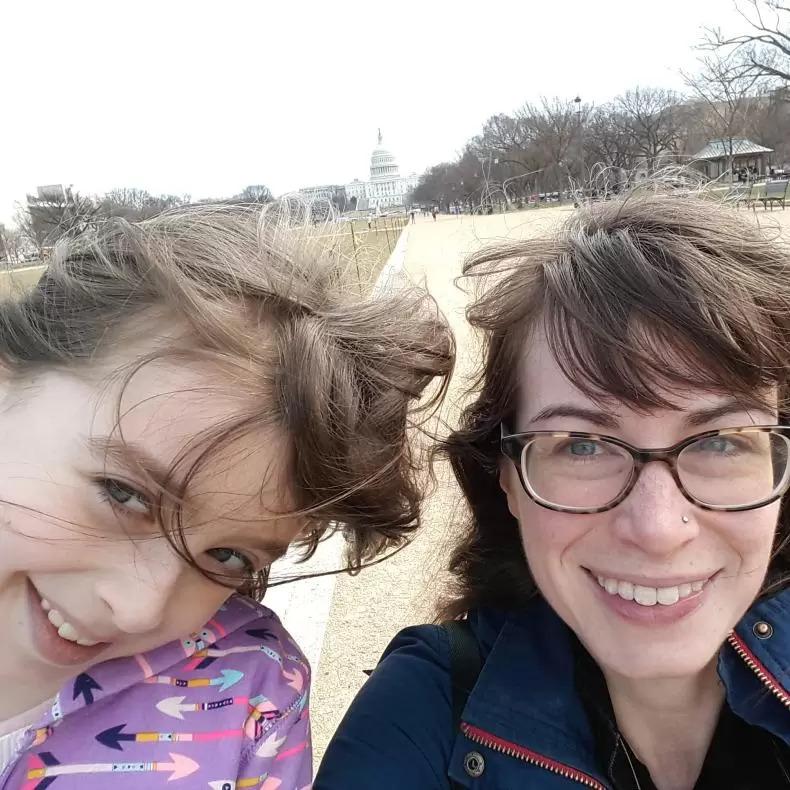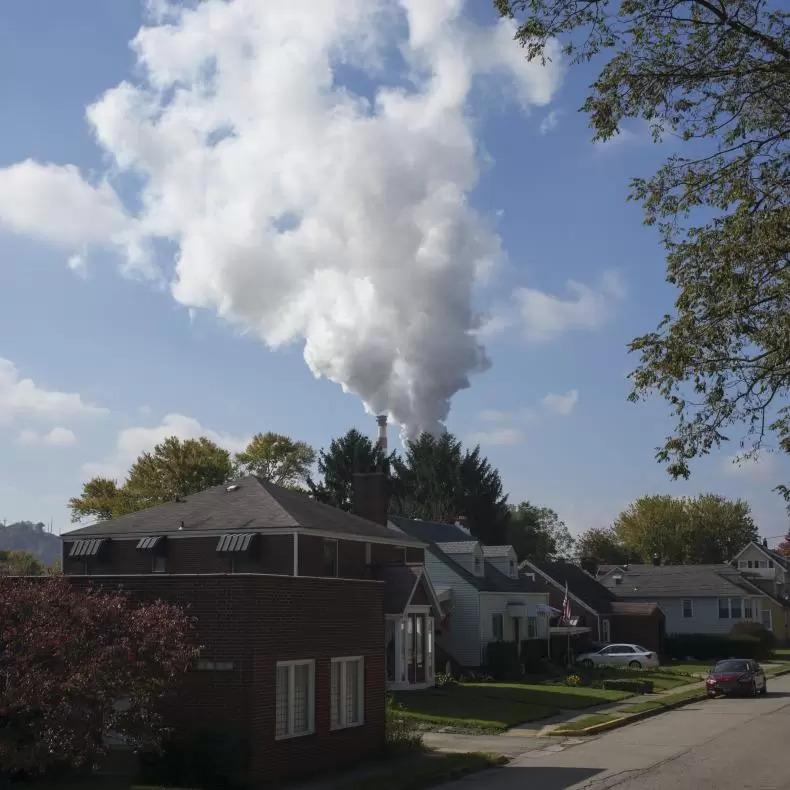Pennsylvania puts a price on carbon
Brooke Petry hasn’t owned a car in 20 years and loves it. It’s one of her favorite things about living in Philadelphia — she can walk everywhere she needs to go.
Unless of course the pollen counts are high or there’s a ground-level ozone warning in effect. Then Petry has to start making decisions most people don’t have to think about.

“I check my phone for the latest air quality alert… and then do this crazy calculus to figure out if it’s safe for me to get groceries,” says Petry.
Like more than 26 million other Americans, Petry has asthma. Last September, it got so bad she ended up in the emergency room.
Petry’s 12-year-old daughter, Eleanor, has asthma, too. In fact, 21% of children in Philadelphia have asthma — more than twice the national average. That’s no surprise: Pennsylvania has some of the worst air quality, and more premature deaths per capita from air pollution, than any other state in the country.
The link between asthma and climate pollution
It’s no coincidence that Pennsylvania is also the nation’s third largest producer of electricity, and the majority of it comes from burning coal and natural gas. This spews more than 73 million tons of climate-warming gasses into the air each year, together with toxic mercury and other heavy metals, as well as the soot, sulfur dioxide and nitrogen oxides that contribute to the formation of the smog that make it hard for Petry and her daughter to breathe.
“We will never make meaningful progress in cleaning up our air until we clean up our power sector,” says Petry, a field organizer for Environmental Defense Fund affiliate Moms Clean Air Force.
Making big polluters pay for their emissions
Petry’s wish may soon come true. After a three-year battle, Pennsylvania is poised to link with a major climate initiative, the Regional Greenhouse Gas Initiative, or RGGI, that will cut carbon dioxide emissions from the power sector and reduce the state’s dependence on dirty fossil fuels.
RGGI cuts carbon dioxide emissions by placing a declining cap on the amount power plants are allowed to emit. It also makes the power plants pay for each ton of CO2 they do release. In addition to creating an enforceable limit on pollution, this makes the electricity from dirty power plants less competitive than cleaner sources, such as wind and solar.
Since its launch in 2009, RGGI states, whose members include 11 Northeastern and mid-Atlantic states, have slashed carbon pollution from the power sector by more than 50% — twice as fast as the nation as a whole — and netted more than $4 billion in proceeds to invest in state programs.
Pennsylvania's climate promise

After Pennsylvania joins RGGI, its carbon pollution will be reduced by some 188 million tons over the next 10 years — equal to taking four million cars off the road. Over the same period, the state’s Department of Environmental Protection estimates that improvements in air quality will lead to 30,000 fewer hospital visits, 639 fewer premature deaths from respiratory disease and more than 45,000 fewer childhood asthma attacks.
“Cleaning up the power sector is really the linchpin to meeting the nation’s climate goals over the next decade,” says Pam Kiely, EDF’s associate vice president for U.S. climate, whose team pushed hard to get Pennsylvania Gov. Tom Wolf, a Democrat, to join RGGI. “Nationwide, we have to secure at least an 80% reduction in power plant pollution by 2030 to have a fighting chance to deliver on the United States’ commitment to cut pollution economy-wide 50-52% by 2030.”
The governor hopes to direct proceeds from RGGI — projected to be potentially hundreds of millions of dollars annually — to help communities affected by the changes happening in the energy sector and to clean up air pollution in the hardest hit areas. Gov. Wolf also plans to use RGGI revenue to build cleaner, more efficient energy, industrial and commercial sectors across Pennsylvania.
Despite the fact that 79% of Pennsylvanians — including 66% of Republicans — support limiting carbon pollution from power plants, getting RGGI across the finish line in Pennsylvania was an uphill battle, with the state’s Republican-controlled legislature attempting to block the process at every opportunity.
After the legislature failed to enact measures to address critical climate and energy policy issues, Gov. Wolf announced in 2019 that he would proceed by executive action.
“Governors don’t have to wait for legislatures to act,” says Kiely. “And they can’t hide behind the recalcitrance and inaction of their legislatures, because they have powerful tools in their regulatory toolboxes to go after pollution right now. Gov. Wolf is showing just how effective executive action can be.”
Carbon markets promote clean energy jobs
EDF helped devise the technical and legal case for the governor to take action under the state’s existing clean air laws. It also helped build the public awareness of, and support for, RGGI that empowered the governor as he fought back against the program’s determined opponents.
“The coal and oil and gas industries are powerful forces in Pennsylvania politics,” says Mandy Warner, EDF’s climate and clean air policy director. So are the unions in those industries, where workers have been told that RGGI will be the end of coal and the reliable jobs it supports in Pennsylvania.
But the reality, according to Warner, is that 42 coal-fired units in Pennsylvania have been retired since 2009 and most of the state’s six remaining plants are already scheduled to be retired or converted to natural gas.
“These workers are facing a tough transition whether or not RGGI comes into effect,” Warner says. “The difference is that with RGGI, you will have hundreds of millions of dollars to invest in those communities. Over the past decade, we’ve seen coal plant after coal plant retire in Pennsylvania. In some cases, they’ve gotten little to no warning from the plant operators, and they’ve gotten virtually no support at all from the state legislature.”
If all goes according to plan, Pennsylvania will officially join RGGI in July, 2022. It will be a momentous day.
“Pennsylvania powers much of the New England and mid-Atlantic region,” says Warner. “What happens in this state matters not just in terms of whether it can meet its own climate goals, but whether the region and even the nation can meet theirs.”
Petry, who as part of Moms Clean Air Force, worked hard for this day to come, is relieved the finish line is finally in sight.
“Like all parents, I want to leave something better for my kid,” she says.
Major study: RGGI is good for kids
A study by researchers from the Columbia University Mailman School of Public Health found that the Regional Greenhouse Gas Initiative, a multistate agreement to slash emissions from the power sector across Northeastern and mid-Atlantic states, has substantially improved children’s health.
The study looked at nine states participating in RGGI from 2009-2014 and found that the initiative had avoided an estimated 537 cases of childhood asthma, 112 preterm births, 98 cases of autism spectrum disorder and 56 cases of term low birth weight. The health cost savings totaled $350 million over the five-year study period.
The results come from a reduction in the amount of fine particle pollution, commonly known as soot, in the air. The combustion of fossil fuels is a major source of this type of pollution. When inhaled, these tiny, airborne particles can lodge in the lungs and enter the bloodstream causing multiple health complications, particularly in children.
“After more than 20 years of studying the devastating health impacts to children of exposure to toxic air pollution from the burning of fossil fuels, I’m thrilled to be able to at last shed light on some good news,” says Dr. Frederica Perera, Director of the Columbia Center for Children’s Environmental Health. “Cleaning up our air can make a real, measurable and immediate positive impact. This research should give the public hope and encourage policymakers to take climate action.”


